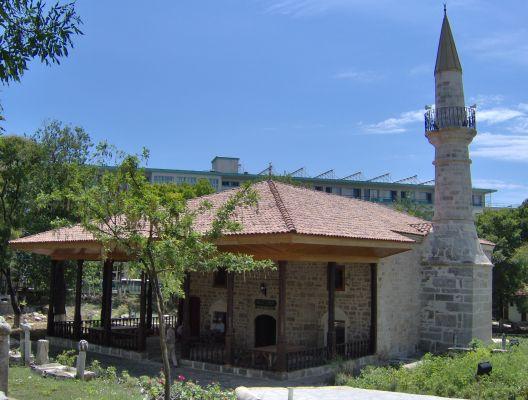
There are many other lands Islam reached that many from amongst the Ummah may not be aware of, such as Western China, Greece, Southern Italy, Hungary and maybe even Austria. Romania is also one such land that many may not be aware lived under Islamic rule for 800 years. Many may not even know where Romania is, it is only 275 miles from Turkey.

The Mangalia Mosque, the oldest mosque in Romania, built in 1575 by Esmahan, the daughter of Ottoman sultan Selim II
There are many countries in the world where Islam springs to mind when they are mentoned, Saudi Arabia, Malaysia and Morrocco are just a few. There are many other lands Islam reached that many from amongst the Ummah may not be aware of, such as Western China, Greece, Southern Italy, Hungary and maybe even Austria. Romania is also one such land that many may not be aware lived under Islamic rule for 800 years. Many may not even know where Romania is, it is only 275 miles from Turkey.
In Europe Romania is infamous for Transylvania – home of Count Dracula. Whilt this character has assumed a position archetypal vampire in populer Western culture; the character is based upon Prince of Wallachia. Vlad III, who came to be known as the impaler. Historically, Vlad Dracula became infamous for his resistance against the Uthmani Khilafah and for the cruel punishments he inflicted upon his enemies.
Vlad Dracula was sent in 1475 with an army of Hungarian and Serbian soldiers to recapture Bosnia from the Uthmani Khilafah. Whilst the Uthmani Khilafah lost this initial battle, the Uthmani’s entered Wallachia in 1476 under the command of Mehmed II to recapture the lost lands. During the war, Vlad was killed and, according to some sources, his head was sent to Constantinople to discourage the other rebellions.
According to most sources in Romania, Islam first emerged when the Sufi leader Sari Saltik came to the region during the Byzantine epoch. The Islamic presence in Northern Dobruja was expanded by Uthmani Khilafah who oversaw successive immigration. In Wallachia and Moldavia, the two Danubian Principalities, the era of Uthmani’s did not accompany growth in the number of Muslims, whose presence there remained small. Also the battles between the Uthmani’s and Habsburg Empire led to many Muslim to move to the Islamic heatlands.
Romania emerged in 1859 as a union of the principalities of Moldavia and Wallachia. Northern Dobruja became part of Romania following the Russo-Turkish War of 1877-1878. However during the the communist regime, Romanian Muslims were subject to a number of harsh measures, especially supervision by the state. The Ummah in Romania managed to hold on to the deen and were able after the Romanian Revolution of 1989 to begin the open dawah to Islam.
Islam in Romania is followed by only 0.3 percent of population, this equates to around 60,000 people, but has more than 800 years of tradition in Northern Dobruja, a region on the Black Sea coast which was part of the Uthmani Khilafah for almost five centuries (ca. 1420-1878). In present-day Romania, most adherents to Islam belong to the Tatar and Turkish ethnic communities.
The vast majority of Romanians are Sunnis who adhere to the Hanafi madhab.
97% of Romanian Muslims are residents of the two counties forming Northern Dobruja: eighty-five percent live in Constanţa County, and twelve percent in Tulcea County. The rest mainly inhabit urban centers such as Bucharest, Brăila, Călăraşi, Galaţi, Giurgiu, and Drobeta-Turnu Severin.
In all, Romania has as many as eighty mosques, or, according to records kept by the Romanian Ministry of Culture and Religious Affairs, seventy-seven. The city of Constanţa, with its Carol I Mosque and the location of the Muftiyat, is the center of Romanian Islam; Mangalia, near Constanţa, is the site of a monumental mosque, built in 1525. The two mosques are state-recognised historical monuments, as are the ones in Hârşova, Amzacea, Babadag and Tulcea. There are also 108 Islamic cemeteries in Romania.
After the Romanian Revolution in 1989, when Romania left the Eastern Communist camp native Romanians had the chance to discover Islam and taste its fruits. Today as many as 3,000 Muslim are converts to Islam and the number is growing day by day. Being converts they faced the particular problem in a society, in that society was not prepared to accept them. Most groups in Romania show little will to support Muslims generally. For these reasons the Ummah in Romania were forced to create an organisation capable of defending and maintaining the needs of the Ummah in Romania. The Alliance of Romanian Muslim was set up in order to protect and defend the Ummah and Islam in Romania.
When Islam came to Europe the continent was living in the dark ages. Eastern Europe was steeped in superstition, magic and sorcery. Islam came and brought a new rational belief that took the region from its misery and gave their lives purpose. Whilst in mainland Europe the challenge is to defend the deen, in Romania and many parts of Eastern Europe once again the people need liberation from capitalism and nationalism and it is here the Muslim of Romania are at the forefront carrying on the work the Prophet Muhammad صلى الله عليه وسلم started and the Uthmani Khilafah expanded. Whilst the Ummah face the same issues globally, the Ummah from Romania stand shoulder to shoulder with the Ummah all over the world and await the day Allah sends his blessings.
Your brothers and Sister from Romania
